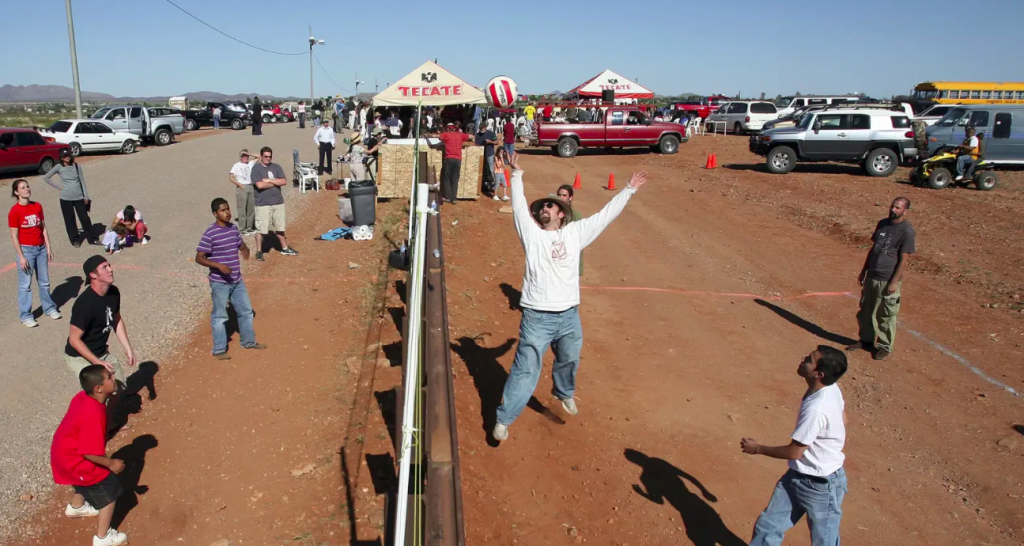International Wallyball
Naco isn’t a town on the U.S/Mexico border. It’s two. Naco, Arizona sits on the north side of the fence; to the south is the Mexican town of Naco, Sonora. (Here’s a map.) The united-but-apart pair date back to 1897, established as a border crossing to allow for the flow of copper mined in the area. Over the century since, and as U.S./Mexico border issues have become increasingly contentious and political, Naco has served as a highly-watched and regulated border crossing between the two nations. Today, on the U.S. side, the Naco Point of Entry is open around the clock, allowing for lawful but regulated entry into the United States for those legally eligible.
Surrounding the actual port of entry, though, is a border wall, one that has been around for nearly fifty years in one way or another. The wall keeps citizens of the two Nacos apart, as walls tend to do. But in years past, it brought them together — over a unique, international game of volleyball.

The picture above, via Quartz, shows a match in action. On the left are Americans, on the right, Mexicans. The game is called “Wallyball” locally and first took place in 1979. Per Quartz, the game is part of an annual celebration called “Fiesta Bi-Nacional,” which is “intended to solidify positive transnational relations between Mexico and the US, despite tensions over migration and other issues.” While many border towns celebrate the event, only Naco and Naco played this unique sport.
Wallyball isn’t quite the same as regular volleyball, in part because the net was solid and extended to the ground. According to Splinter News, it is “a fast-paced version of volleyball where players can hit the ball off the wall,” a necessary rule adjustment given the equipment. According to Univision, residents of the two towns played the game “over the barbed wire fence and under the easy-going watch of border guards.” At first, the barbed wire proved to be a problem, puncturing the ball, but over the years, the participants solved that issue by throwing a tarp over their makeshift net. The winning team was treated to a party at the expense of the losers, and that caused another problem: one had to cross the border to join the party. The solution? According to a self-described town historian (via Univision) named Sixto de la Peña, “we fixed that by cutting a hole in the fence so that the Mexican side, which always won, could go to the party on the American side.”
The annual tradition ended after 2007; a taller wall made it too hard to play. But every once in a while, people will give an impromptu volleyball match a go at other locations. Here’s a video from 2015 showing one such match in San Diego/Tijuana. And as you’ll see in that video, sportsmanship and transnational relations are part of even these unplanned events — the two sides end their match with a handshake, despite the fact that it probably violates all sorts of laws.
Bonus fact: In the 2000 Tom Hanks film Castaway, Hanks’ character spends most of the movie alone, stranded on an island. His only friend is Wilson, a volleyball that happened to wash ashore while Hanks was otherwise isolated. The idea for Wilson came from screenwriter Bill Broyles, who decided the best way to write about being stranded on a beach was to live it. According to the Austin Chronicle, Broyles went to a “survival camp on an island near Mexico’s Sea of Cortez” to do his research;” he “stayed out there alone for days, where he speared stingrays and ate them raw, where he had to learn how to open coconuts to drain their juice.” Wilson was part of that research; while on this self-forced adventure, Broyles came across an errant Wilson volleyball on the beach, which he talked to during his days-long isolation. Ultimately, Broyles adapted this experience into the script.
From the Archives: Spiking the Sand: Why doesn’t the sand stick to beach volleyball players? (And the bonus fact is about Wilson.)
